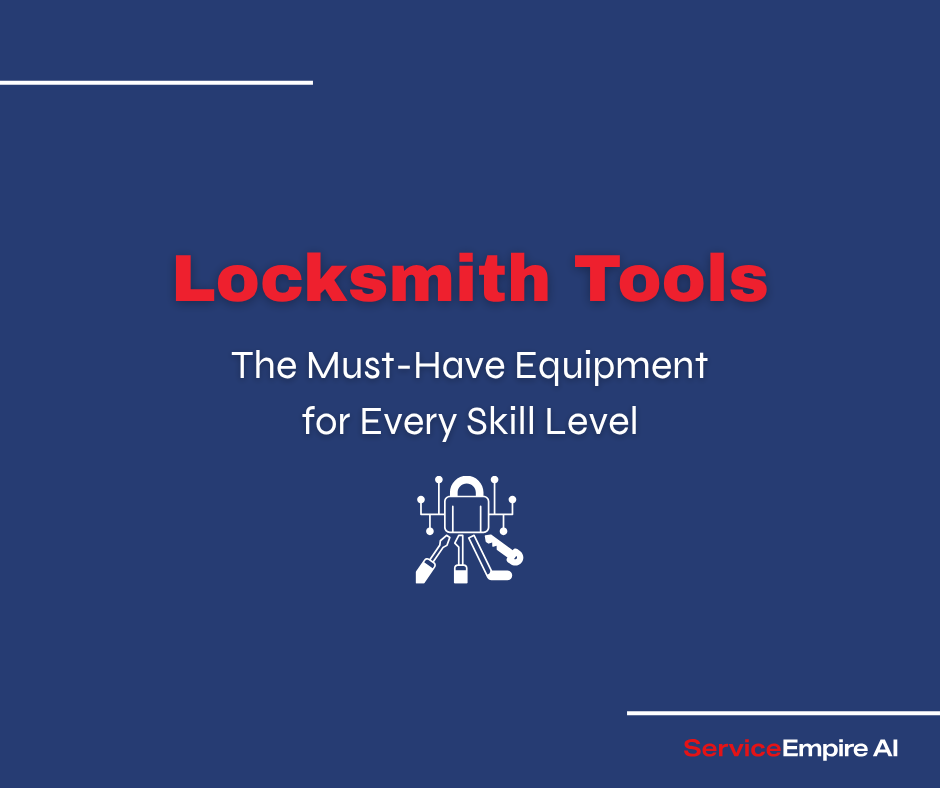
To be a great locksmith, you need to have the right locksmith tools. In the field, you might use small picks to open locks with care. In your shop, you might use a key cutting machine to make perfect copies. Locksmith tools are what turn skill and knowledge into real results. Even the best locksmith can’t do much without the proper tools.
As locks have become more advanced, locksmith tools have also changed. What started as simple tools for basic locks has grown into high-tech gear for handling everything from home locks to cars and digital systems. Modern locksmiths need a wide range of tools to keep up.
This guide covers all the must-have locksmith tools, from simple hand tools to advanced electronic gear, for every part of the locksmith trade.
Understanding Locksmithing Tool Categories
Locksmith tools can be organized into several distinct categories, each serving specific functions within the trade. Understanding these categories helps both new and experienced locksmiths build the right toolkits.
Major Tool Categories
Manual Manipulation Tools These tools allow locksmiths to directly interact with lock mechanisms, including lock picks, tension wrenches, and bypass tools. They're fundamental to non-destructive entry techniques.
Diagnostic Equipment Used to analyze lock conditions, identify key codes, or troubleshoot electronic systems, these include key decoders, scope cameras, and electronic testers.
Key Origination Tools Equipment that creates or duplicates keys, ranging from simple file keys to computerized cutting machines and transponder programmers.
Installation Equipment Tools designed for mounting and installing locks, including hole saws, installation templates, jigs, and specialized measuring tools.
Automotive Specialty Tools Purpose-built for vehicle locks and keys, including long-reach tools, airbag wedges, and transponder programming devices.
Safe and Vault Tools Specialized equipment for opening and servicing high-security containers, including dial micrometers, borescopes, and safe drilling rigs.
Professional vs. Hobbyist Equipment
The distinction between professional and hobbyist tools typically involves several factors:
- Durability: Professional tools are built to withstand daily use and abuse
- Precision: Commercial-grade tools maintain tolerances necessary for sensitive work
- Versatility: Professional sets cover broader applications across different lock types
- Warranty: Professional tools often come with better support and replacement options
- Cost: Quality professional equipment commands premium prices reflecting their construction
"The difference between professional and amateur locksmith tools becomes apparent after your first few jobs," explains John Davidson, a locksmith with 20 years of experience. "Professional-grade equipment maintains precision under repeated stress and remains accurate even after thousands of uses—something hobbyist tools simply can't match."
Essential Hand Tools for Locksmiths
Before delving into specialized lock manipulation equipment, every locksmith needs a foundation of quality hand tools adapted specifically for the precision work of security systems.
Basic Hand Tools
Screwdriver Sets
- Precision screwdrivers in various sizes
- Security bit sets (Torx, square, tri-wing)
- Ratcheting screwdrivers for tight spaces
- Offset screwdrivers for awkward angles
Pliers and Tweezers
- Needle-nose pliers in multiple sizes
- End-cutting pliers for pin removal
- Specialty tweezers for pin manipulation
- Spring-loaded reversible jaw pliers
Files and Wire Brushes
- Key files (round, flat, pippin, warding)
- Needle files for delicate work
- Wire brushes for cleaning locks
- File handles with proper grip
Measuring Tools
- Digital calipers for precise measurements
- Key gauges for determining key depths
- Micrometer for detailed measurements
- Depth and space keys
Specialty Hand Tools
Plug Followers These cylindrical tools support pins when removing a lock cylinder, preventing springs and pins from scattering. They come in various diameters to match different lock types.
Plug Spinners Used to reverse plug rotation quickly, these tools are essential when a lock is picked in the wrong direction.
Cylinder Removal Tools Specialized wrenches and drivers designed to remove specific lock cylinders from housings.
Broken Key Extractors Slender tools with hooks, barbs, or spiral designs that grab broken key fragments within a keyway.
Proper organization of these tools is critical for efficient work. Many professionals use tool rolls with individual pockets, magnetic trays for securing small components, and custom foam inserts in cases to prevent tools from damaging each other during transport.
Lock Picking and Manipulation Tools
Lock picking tools represent the most iconic category of locksmith equipment, allowing non-destructive entry through mechanical manipulation of lock components.
Single Pin Picking Tools
Hook Picks Available in various depths and profiles, hook picks manipulate individual pins within a lock:
- Standard hooks for common pin alignments
- Deep hooks for reaching pins far from the keyway
- Offset hooks for navigating around keyway obstructions
Diamond Picks With diamond-shaped tips that can push pins up or down:
- Standard diamonds for basic locks
- Small diamonds for tight keyways
- Wide diamonds for larger pin chambers
Ball Picks Featuring rounded tips ideal for wafer locks:
- Small ball tips for narrow keyways
- Large ball tips for more substantial pins
- Offset ball designs for complex keyways
Rake Picks Designed to set multiple pins simultaneously through rapid movement:
- Snake rakes with serpentine patterns
- Bogota rakes with multiple peaks
- City rakes with distinct tooth patterns
- L-rakes (or half-diamonds) for wafer locks
Tension Tools
Tension wrenches apply rotational pressure to the lock plug while picking, creating the binding necessary for pin setting:
Top of Keyway (TOK) Tensioners
- Flat bar tensioners with various thicknesses
- Notched TOK wrenches for better grip
- Serrated tensioners for preventing slippage
Bottom of Keyway (BOK) Tensioners
- Standard Z-shaped tensioners
- Twisted tensioners for better feel
- Spring-loaded tensioners for consistent pressure
If the tool has too much give, aka the tolerances are wide, it can make picking the lock much tougher.
Bypass Tools
These specialized tools exploit design vulnerabilities in certain locks, bypassing the normal locking mechanism:
Shims Thin metal or plastic sheets that slip between the shackle and body of padlocks or between door components.
Under-Door Tools Long, flexible tools that can reach around doors to manipulate latches or deadbolt thumbturns from the opposite side.
Latch Slipping Tools Tools designed to retract spring-loaded latches by applying pressure between the door and frame.
Electric and Manual Pick Guns
These tools provide mechanical or electric vibration to bounce pins to the shear line:
- Electric pick guns with adjustable impact force
- Manual snap guns with spring-loaded impacts
- Vibrating pick tools for rapid pin setting
Impressioning Tools
Used to create working keys directly from locks:
- Impressioning files with fine teeth
- Key clamps to hold blanks during filing
- Magnifiers to see impressioning marks
- Marking agents (smoke, aluminum powder, etc.)
Key Cutting and Duplication Equipment
Key cutting represents a fundamental aspect of locksmith services, requiring specialized equipment to create precise duplicates and originals.
Manual Key Machines
Traditional key duplicators operate through mechanical guidance systems:
- Tracer arm follows original key pattern
- Cutting wheel duplicates pattern onto blank
- Calibration systems ensure accuracy
- Alignment jigs position keys properly
These machines require skill to operate properly but offer reliability and precision for standard key systems. Maintenance includes regular cleaning, lubrication, and occasional replacement of cutting wheels.
Automatic Key Cutting Machines
Modern computerized key machines offer enhanced features:
- Code cutting capabilities from manufacturer specifications
- Electronic calibration for precision
- Database integration with thousands of key specifications
- User-friendly interfaces reducing training requirements
Advanced models connect to online services for continuous updates to key codes and specifications, keeping pace with new security systems.
Specialty Key Machines
Automotive Transponder Equipment Combines physical cutting with electronic programming:
- Integrated code readers and programmers
- Vehicle database connection
- Clone capabilities for certain transponder types
High-Security Key Systems Designed for complex key patterns:
- Laser key cutting capabilities
- Sidewinder and track key machines
- Tibbe key cutting attachments
Dimple Key Machines Specialized for dimple lock systems:
- Multi-axis cutting capabilities
- Precision depth control
- Template systems for various manufacturers
Automotive Locksmith Tools
Vehicle security systems present unique challenges requiring specialized locksmith tools designed specifically for automotive applications.
Vehicle Entry Tools
Air Wedges Inflatable cushions create space between door frames and weather stripping without damaging vehicle components.
Long Reach Tools Slender rods with various end attachments:
- Hook ends for pulling unlock buttons
- Loop ends for turning lock knobs
- T-handle attachments for electronics
- J-tools for specific vehicle designs
Slim Jim Tools Thin metal strips designed to slip between window glass and door panel to manipulate lock rods.
Key Programming Equipment
Transponder Programmers Electronic devices that communicate with vehicle immobilizer systems:
- Universal programmers for multiple manufacturers
- Brand-specific programmers with deeper capabilities
- OBD-port connections for direct computer access
- Proximity key programmers for smart systems
Key Code Readers Tools that extract key codes from vehicle locks or computer systems:
- Lock readers for direct extraction
- OBD interface readers for computer extraction
- VIN-based code lookup systems
Lock Removal and Installation Tools
Specialized for vehicle-specific lock mechanisms:
- Door panel removal tools with non-marring edges
- Steering column access kits for ignition work
- Ignition lock decoders for pin reading
- Door handle spring tools for quick removal
The automotive locksmith specialty continues to evolve rapidly with vehicle technology, requiring continuous investment in new equipment and training.
Electronic and Smart Lock Tools
As electronic security systems become increasingly common, locksmiths must adapt with specialized tools for these sophisticated mechanisms.
Diagnostic Equipment
Tools for troubleshooting electronic lock systems:
- Multimeters for electrical testing
- Logic probes for signal verification
- Battery analyzers for power issues
- Control board testers for component verification
Programming Interfaces
Software and Hardware Tools
- Manufacturer-specific programming devices
- Universal smart lock interfaces
- Mobile applications with Bluetooth connectivity
- Firmware update equipment
Installation Tools
Specialized equipment for electronic lock mounting:
- Cable fishing tools for hidden wiring
- Wire strippers and crimpers for connections
- Template jigs for consistent installations
- Specialty drill bits for clean cable pathways
"Electronic lock work has transformed from a niche specialty to a mandatory skill set for modern locksmiths. Without proper diagnostic tools, even simple troubleshooting becomes nearly impossible on today's integrated systems," explains Jorge Torres, electronic security specialist.
Safe and Vault Manipulation Tools
Safe and vault work represents one of the most specialized and technical areas of locksmithing, requiring unique tools designed specifically for these high-security containers.
Dial Manipulation Equipment
Tools for non-destructive safe opening:
- Auto-dialers with computerized movement
- Dial micrometers for precise measurement
- Amplification devices for detecting internal mechanisms
- Dial spinners for rapid combination attempts
Safe Drilling Tools
When manipulation fails, controlled drilling provides access:
- Hardened drill bits for penetrating hardplate
- Drill rigs with precise alignment control
- Borescopes for internal inspection
- Scopes with light sources for visibility
Safe Opening Kits
Comprehensive systems for professional safe technicians:
- Change keys for combination adjustments
- Hole plugs for repair after drilling
- Relocking trigger neutralizers
- Punch sets for spindle removal
Safe work requires extensive training beyond tool familiarization, with many professionals spending years developing the necessary skills.
Lock Installation and Door Hardware Tools
Professional lock installation ensures security systems function as designed while maintaining door integrity and proper operation.
Door Preparation Tools
Installation Templates Manufacturer-specific guides that ensure precise positioning:
- Face plate templates for perfect alignment
- Strike plate positioning guides
- Backset measurement tools
- Edge boring guides
Hole Saws and Drill Bits Specialized cutting tools for clean installation:
- Bi-metal hole saws for door face boring
- Spade bits for edge boring
- Installation kits with integrated depth stops
- Arbors with pilot bits for accurate centering
Mortising Equipment Tools for creating recesses for lock components:
- Mortise chisels in various widths
- Corner chisels for clean edges
- Router templates for power mortising
- Jigs for consistent depth control
Strike Plate Installation Tools
Specialized equipment for precise strike mounting:
- Deep pocket chisels for strike box creation
- Strike locators for perfect alignment
- Reinforcer installation kits
- Spacer gauges for gap measurement
Electric Strike Installation Equipment
Tools for electronic strike mounting:
- Low-voltage wire installation tools
- Power supply testers
- Specialized cutters for metal frames
- Template guides for electric strike cutouts
Proper installation tools not only speed up the job but also improve the final result. The difference between a professional installation and an amateur one is immediately visible in the alignment, function, and longevity of the hardware.
Beginner Locksmith Tool Kits
Those entering the locksmith trade often struggle with initial tool selection, balancing budget constraints against quality requirements.
Essential Starter Kit Components
A foundational locksmith toolkit should include:
Basic Lock Picking Set
- 2-3 hook picks (standard, deep)
- 2-3 rake picks (snake, bogota)
- 5-6 tension tools (TOK and BOK)
- Broken key extractors (2 styles)
Hand Tools
- Precision screwdriver set
- Needle-nose pliers
- End-cutting nippers
- Key file set
Automotive Basics
- Slim jim or reach tool
- Air wedge
- Plastic shims
Installation Basics
- Installation template
- Basic hole saw kit
- Utility knife
- Measuring tools
Quality vs. Price Balance
Beginning locksmiths should invest in moderation, focusing on versatile tools that serve multiple purposes. It's better to have fewer high-quality tools than many poor-quality ones that will fail when needed most.
Entry-level locksmiths might budget:
- $200-300 for a quality beginner's pick set
- $100-150 for essential hand tools
- $200-250 for basic installation tools
- $150-200 for starter automotive tools
Common Beginner Mistakes
New locksmiths often make predictable tool selection errors:
- Purchasing excessively large pick sets with rarely used tools
- Selecting low-quality tools that provide poor feedback
- Overlooking the importance of quality tensioning tools
- Investing in specialty tools before mastering fundamentals
- Underestimating the importance of proper storage and organization
Professional Locksmith Tool Investment
Established locksmiths approach tool acquisition as a strategic business investment requiring careful consideration and planning.
Business Considerations
Professional tool purchases should reflect:
- Service breakdown (residential, commercial, automotive percentages)
- Specialization areas requiring specific equipment
- Frequency of use for cost justification
- Labor savings from efficiency improvements
- Competitive advantages gained
Return on Investment Analysis
Major equipment purchases should undergo ROI analysis:
- Initial purchase cost vs. expected useful life
- Labor time saved × hourly rate
- Additional service capabilities
- Reduced outsourcing expenses
- Tax advantages through depreciation
Tool Warranty and Support
Professional-grade tools typically offer:
- Extended warranties reflecting quality construction
- Manufacturer support and troubleshooting
- Repair services and parts availability
- Training resources and documentation
- Trade-in programs for upgrades
Tool Organization and Mobile Setups
Efficient tool organization dramatically impacts service speed and professionalism, particularly for mobile locksmiths.
Tool Bag and Case Options
Backpacks Hands-free transportation with multiple compartments:
- Specially designed with tool-specific pockets
- Reinforced bottoms for durability
- Padded compartments for electronic equipment
Rolling Cases Wheeled solutions for heavier equipment:
- Hard-shell protection for sensitive tools
- Expandable handles for easy transport
- Modular systems with removable sections
Vests and Belts Wearable organization for frequently used tools:
- Multiple pocket configurations
- Quick-access tool holders
- Weight distribution design
Vehicle Organization Systems
Mobile locksmiths require efficient vehicle setups:
- Wall-mounted pegboards for visual organization
- Drawer systems with foam inserts for security
- Bench areas for on-site work
- Power inverters for electronic equipment
- Lock boxes for high-value tools
- Inventory management systems for stock
Legal and Ethical Considerations
Possession of locksmith tools carries legal and ethical responsibilities that professionals must understand and respect.
Restricted Tool Purchase Requirements
Many jurisdictions regulate the sale and possession of locksmith tools:
- Licensing requirements for purchasing
- Registration of certain tools
- Background checks for specialized equipment
- Restricted sales of manipulation devices
Professional Licensing Requirements
Locksmith licensing varies by location but may include:
- Background checks and fingerprinting
- Professional certification requirements
- Business licensing beyond personal credentials
- Ongoing education requirements
- Documentation of tool inventory
Ethical Use Guidelines
Professional locksmiths adhere to ethical standards:
- Verification of client authority before service
- Proper identification and record-keeping
- Confidentiality regarding security systems
- Responsible refusal of suspicious requests
- Proper disposal of keys and sensitive materials
The tools in your possession have significant power and its your responsibility to use them wisely.
Future of Locksmith Tools: Innovations and Trends
The locksmith industry continues to evolve with technological advances creating new tool categories and capabilities.
Electronic Diagnostics Advancements
Modern diagnostic equipment trends include:
- Wireless connectivity to manufacturer databases
- Real-time troubleshooting guidance
- Augmented reality visualization of mechanisms
- Remote consultation capabilities
3D Printing Applications
Emerging applications include:
- Custom tool creation for unique locks
- On-demand key blank production
- Specialty parts manufacturing
- Prototype development for custom solutions
Smart Tool Integration
Next-generation tools feature:
- Bluetooth connectivity with smartphones
- Data logging of service activities
- Integrated cameras for documentation
- Remote diagnostics capabilities
It will be interesting to see what locksmith equipment looks like over the next decade. Locksmiths will have to learn and adapt as the physical and digital worlds continue to merge.
Visit this online store to get started on your locksmith toolkit.
Conclusion
Locksmith tools are at a fascinating intersection of ancient craft and cutting-edge technology. From simple tension wrenches to sophisticated electronic diagnostic equipment, these specialized implements enable security professionals to protect property and provide essential services to their communities.
Quality locksmith tools serve as both the foundation and limiting factor for professional capability. By understanding the various categories, applications, and selection criteria for these specialized implements, both novices and experienced professionals can build appropriate toolkits for their specific needs and specializations.
As security technology continues to evolve, so too will the tools designed to service these systems, creating an ongoing process of adaptation and learning for dedicated locksmith professionals.
FAQ Section
What tools do I need to start learning locksmithing?
Beginners should start with a quality basic pick set (hooks, rakes, and tension tools), precision screwdrivers, needle-nose pliers, and a set of key files. These fundamentals allow practice on basic lock mechanisms without overwhelming investment. Add tools gradually as skills develop and specific interests emerge.
How much should I budget for professional locksmith tools?
A comprehensive professional toolkit typically requires $3,000-$8,000 initial investment, with key cutting machines representing the largest single expense ($1,000-$5,000 depending on capabilities). Budget approximately 5-10% of annual revenue for ongoing tool maintenance, replacement, and upgrades to maintain competitive capabilities.
Are cheap lock picking sets worth buying?
Entry-level pick sets under $50 typically offer poor feedback, imprecise tolerances, and rapid wear—creating frustration rather than skill development. Beginners are better served by investing $100-200 in a smaller selection of quality picks from reputable manufacturers that provide the feedback necessary for developing proper technique.
Do I need different tools for automotive work vs. residential?
Yes, automotive locksmith work requires specialized tools distinct from residential services. While some basic tools overlap, vehicle entry tools, transponder programmers, and automotive key machines are designed specifically for vehicle applications and represent separate investments from residential locksmithing equipment.
What are the most commonly used locksmith tools daily?
Professional locksmiths report screwdrivers, key cutting equipment, pick guns, basic pick sets, plug followers, and key gauges as their most frequently used tools. Mobile locksmiths particularly rely on non-destructive entry tools and portable key machines for daily service calls.
Are there legal restrictions on owning locksmith tools?
Many jurisdictions restrict the sale, possession, or transportation of locksmith tools to licensed professionals only. These restrictions vary significantly by location—some areas require professional licensing to purchase pick sets, while others have no restrictions. Always research local regulations before purchasing or transporting locksmith tools.
Note: We also have HVAC Tools List and Plumber Tools List.






